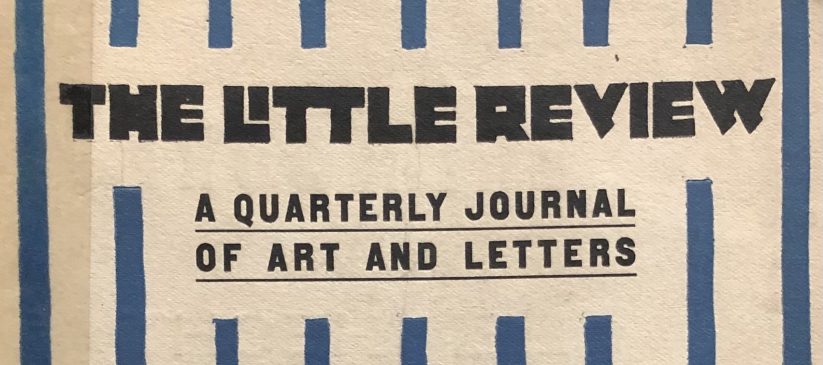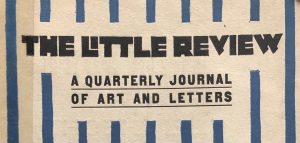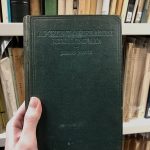100 Years of Ulysses

In light of our recent announcement regarding the acquisition of the Solange and Stephen James Joyce Collection, Graduate Trainee Library Assistant Hollie Piff explores the Ulyssean links already present in the University of Reading Special Collections.
I came to the University of Reading Special Collections with a passion for modernist literature. During my English Literature degree I studied modules that exposed me to Faulkner, Hemingway, Mansfield, Beckett, and, of course, Joyce. As soon as I got the chance I hunkered down and pored through the catalogue, searching to find any hidden gems amongst the stacks. Well reader, I was successful.
To celebrate the 100th anniversary of Ulysses’s publication in book form (and to celebrate Joyce’s 140th birthday) we shall follow this mighty text’s journey to publication, starting with its tumultuous serialisation in The Little Review.
Big innovation, little magazines
I completed a research project on modernist little magazines in my final year of University, so when I stumbled upon a 1921 edition of The Little Review in our Reserve Collection I couldn’t hold in my excitement. I had been using the Modernist Journals Project website to view the magazines during lockdown, so holding a genuine copy in my hands was surreal. The Autumn 1921 ‘Brancusi Number’ is striped in blue, softened by 100 years of wear, and as I carefully flicked through the pages I found something rather interesting–an advert for the publication of Ulysses by James Joyce. Not only this, but the final line of the edition, a note by ‘jh’ (otherwise known as Jane Heap, co-editor of The Little Review) reads: “Before we could revive from our trial for Joyce’s ‘Ulysses’ it was announced for publication in book form. We limp from the field.” The publication of Joyce’s most famous novel was far from a walk around Dublin, so to speak.
So, what is a modernist little magazine? Suzanne W. Churchill and Adam Mckible, writing for American Periodicals, admit the difficulty of drawing a clear definition of the modernist little magazine without excluding more mainstream, or more fringe, publications. Their definition seeks to include the broad spectrum of content, audiences, and aims, concluding that “little magazines are non-commercial enterprises…intent upon publishing the experimental works or radical opinions of untried, unpopular, or under-represented writers…some little magazines aim to uphold higher artistic and intellectual standards than their commercial counterparts, while others seek to challenge conventional political wisdom and practice” (4). The Little Review was at the fore of the experimental literary and artistic world, and its motto: ‘Making No Compromise with the Public Taste,’ succinctly sums up its opinion of the mainstream. Led by Margaret Anderson, Jane Heap and, for a time, Ezra Pound, The Little Review ran from 1914 to 1929, and its radical sentiments meant it wasn’t short on controversies.
Joyce and The Little Review
Being published in the little magazines not only gave writers access to an open-minded literary audience, but they often had a more practical perk: money. James Joyce “was perennially bad with money” (Mullin) and consequently, as Claire Hutton suggests, was attracted “by the prospect that he could be paid ‘double fees’ for the simultaneous serialisation of Ulysses in both The Egoist in London and the Little Review in New York” (84). Although some little magazines could barely afford to print their own editions, let alone pay their contributors, for writers that could find the patrons, serialisation allowed for a regular (albeit small) income. After all, starving artists aren’t starving for fun. Serialisation also helped to tame Joyce’s erratic writing style, forcing him to complete the novel chapter by chapter, although without formal deadlines.

The Little Review started to publish Ulysses in March of 1918, and while the mainstream public often found Joyce’s work obscene and abhorrent, readers of The Little Review soon wrote to Heap and Anderson to proclaim how grateful they were for Ulysses during these “beastly times” (TLR, Vol. 5, No. 1). By January 1919, copies of The Little Review that contained the first part of ‘Lestrygonians’ were confiscated by the post office, as well as the May 1919 copies.The 1917 Espionage Act “gave Post Officials the power to examine any item that was posted in order to assess whether it was ‘indecent or immoral’,” and The Little Review likely fell foul of these prudish laws (Hutton 40). The confiscation of material in 1919 and early 1920 didn’t stop Heap and Anderson from continuing to publish Ulysses, but when an unsolicited copy of The Little Review found its way into the hands of the daughter of a “reputable and leading member of the bar,” the legal case against them picked up steam (Hutton 109).
Trials and tribulations: 1921
After a preliminary hearing in October 1920, the trial began in earnest on the 14th February 1921 and was adjourned until the 21st of February to allow the judges time to read the offending material. With Ulysses held up as evidence, the case became somewhat of a close-reading exercise, rather more at home in a classroom than a courthouse. Eventually, Heap and Anderson were convicted, charged a mere $50 each for their crimes, and warned not to publish any more obscene literature (Weir 400). However, Anderson and Heap’s diminutive punishment was not representative of the impact this ruling had on The Little Review and Ulysses. David Weir suggests that the trial of The Little Review not only influenced the trajectory of Ulysses, but that it impressed itself upon the content of the text. Weir notes that, while we can never be certain of the influence of the 1921 trial on the writing of Ulysses, there is evidence that “Joyce continued to thicken the texture of legal jargon in the court scene [of the chapter ‘Circe’] as the book neared publication” (399). This mutual influence, between the little magazines and their contributors, epitomises the communal nature of the modernist movement.
The path to publication: Sylvia Beach
After the trial of Anderson and Heap, publication of Ulysses in America was effectively prohibited, and finding somebody that had the means, as well as the guts, to publish Ulysses in book form turned out to be a complicated matter. Harriet Shaw Weaver, editor at The Egoist, had published A Portrait of the Artist as a Young Man in both serialised and book form, and between 1918 and 1921 attempted to publish Ulysses. Weaver contacted Virginia and Leonard Woolf at the Hogarth Press, but they simply did not have the means to print such a tome. Now living in Paris, Joyce despaired to his friend Sylvia Beach, owner of Shakespeare and Company, that his book would never be published in its entirety, to which she replied that she would publish it herself. Beach had long admired Joyce’s writing, but she had no experience with fine printing, and so she enlisted the help of printer Maurice Darantiere to produce 1,000 copies (Arnold 18).

By the time Ulysses reached Beach, it was clear that the mythical drama surrounding its content, publication, and author had made it easily marketable. The advert for Ulysses, which can be found on page 107 of The Little Review’s Brancusi number, reflects this infamy: “ULYSSES suppressed four times during serial publication,” the headline reads. Beach’s marketing acumen came in handy when Joyce’s incessant editing and redrafting caused the publication process to drag on past the autumn 1921 deadline, and she had to appease disappointed subscribers.
Finally, after drafting and redrafting, the loss of manuscripts, typists, minds, and wills to live, Ulysses was published on the 2nd February 1922. With blue and white wrappers to match the exact shades of the Greek flag, the book weighed 1.55 kilograms and crowds allegedly gathered to see this world-changing book at Shakespeare and Company (Arnold 27).
In conclusion…
Like The Odyssey, this story doesn’t end with the neat homecoming of the long awaited hero, but I’m afraid that’s all we have time for here. We are all incredibly excited to be receiving the Solange and Stephen James Joyce collection, and this tale of The Little Review is only one of the intricate connections that ties the University of Reading’s Special Collections to the work of a modernist great. The collection will be full of international editions of Joyce’s work, including copies of Ulysses in different languages, reflecting the ever-growing interest in the novel that started its journey in The Little Review. Now, more than 100 years later, we hope to enhance understanding of Joyce as a writer, and as a friend of Samuel Beckett, by making this material available to researchers for the first time.
Works Consulted
- Arnold, Bruce. The Scandal of Ulysses. New York, St Martin’s Press, 1992.
- Beach, Sylvia. Shakespeare and Company. London, Faber and Faber, 1959.
- Brooker, Peter and Thacker, Andrew, (eds). The Oxford Critical and Cultural History of Modernist Magazines: Volume II: North America 1894-1960, Oxford, 2012.
- Churchill, Suzanne W., and Adam McKible. “Little Magazines and Modernism: An Introduction.” American Periodicals, vol. 15, no. 1, Ohio State University Press, 2005, pp. 1–5, http://www.jstor.org/stable/20771167.
- Hutton, Clare. Serial Encounters: Ulysses and the Little Review. Oxford University Press, 2019.
- The Modernist Journals Project (searchable database). Brown and Tulsa Universities, ongoing. www.modjourn.org
Mullin, Katherine. “Money in James Joyce’s Dubliners.” British Library, 25 May 2016, https://www.bl.uk/20th-century-literature/articles/money-in-james-joyces-dubliners.
Weir, David. “What Did He Know, and When Did He Know It: The ‘Little Review,’ Joyce, and ‘Ulysses.’” James Joyce Quarterly, vol. 37, no. 3/4, University of Tulsa, 2000, pp. 389–412, http://www.jstor.org/stable/25477749.